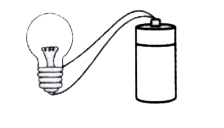Irshad connected a bulb to a cell as shown but the bulb did'not glow. What could be the reason?

The bulb could be fused i.e its filament was broken
the cell was dead chemical was used up
Topper's Solved these Questions
Similar Questions
Knowledge Check
Question Stimulus :-
An electric circuit is made using a torch cell, a bulb and copper wires. The bulb does not glow. The reason may beAthe copper wires have more length than what is requiredBthe torch cell is connected with its polarity reversedCthe torch cell is touched by the handDthe copper wire does not touch the cellIn which case does the bulb glow ?
A B
B C
C D
D
Paheli connected two bulbs to a cell as shown in Fig. 12.8.

She found that filament of bulb B is broken. Will the bulb A glow in this circuit? Give reason.
View SolutionFig. 12.10 A and B, show a bulb connected to a cell in two different ways.

(i) What will be the direction of the current through the bulb in both the cases. (Q to P or P to Q)
(ii) Will the bulb glow in both the cases?
(iii)Does the brightness of the glowing bulb depend on the direction of current through it?
View SolutionA wire connected to a bulb does not glow, whereas the filament of the bulb gilows when same current flows through them. Why?
View SolutionDraw wires to connet the bulb to the battery so that the bulb glows with maximum brightness.

View SolutionPaheli set up an experiment using liquid A in the beaker as shown in Fig. 14.4. She observed that the bulb glows. Then she replaced the liquid A by another liquid B. This time the bulb did not glow. Boojho suggested replacing the bulb by an LED. They observed that the LED glows. Explain.

View SolutionThree different electrolytic cells A, B and C are connected in separate circuits. Electrolytic cell A contains sodium chloride solution. When the circuit is completed, a bulb in the circuit glows brightly. Electrolytic cell B contains acetic acid solution and in this case the bulb in the circuit glows dimly. The electrolytic cell C contains sugаr solution and the bulb does not glow. Give a reason for each of these observations.
View Solution

